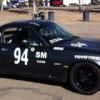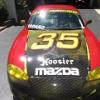Here is the long and short of it - from my perspective. There will be many others who do something different. Figure out what works for you
Get your car on a dyno. Tie it down the same way every time, set your tire pressures the same every time. Take great care to CAREFULLY log Temperature, Relative Humidity and Barometric Pressure with an instrument that you trust that you will take to every track - do not rely on the dyno stack weather station as for most of us, it aint following us to every track.
Make sure your in car data logger is capturing data (this will be helpful to compare with the dyno file that your dyno provides). Warm up the car, get the car into the 190-210F range. Do your dyno runs, and play with FP adjustments until you find the the best combination of HP and TQ - often they will be at odds with each other, but choose something that works for you.
Make sure you record the FP on your in-car gauge and the AF ratio that it gives you at a particular RPM - some choose AF ratio at 6,000RPM, some prefer 6,500RPM and I prefer 6,900 RPM, just prior to the red line. Make sure that you record the delta between the dyno's AF ratio sniffer-probe in the tail pipe and the AF ratio display in your car. There is typically a 0.2 to 0.3 difference as the sniffer in the tailpipe is also getting some ambient oxygen in the tail pipe but your sender in the down pipe is reading pure burnt gasses. Having your data logger with video recording running during your dyno runs allows you to review your in-car gauge values at the same time that you are analyzing the dyno data file, and can be very helpful.
Now you have your baseline. So say for instance at 80F, 70% Relative Humidty and 29,6mm HG Barometric Pressure, your car gives you the best combo of HP and TQ at 53PSI delivering an AF ratio at your chosen RPM point of 12.2.
Now wherever you travel to a track, the first thing you do is look at the weather forecast, and look at your weather station. Based on what you see on your weather station and how you see the weather changing that day, you will need to make an adjustment in FP, either increasing it (Making it richer for the presence of more O2) or (make it leaner for the presence of less O2). After a while you will figure out the working range for your particular car. And you will get good at making adjustments to FP 5 minutes before your session based on what your weather station says.
For my 99 the range is 48PSI to 53PSI - but remember every car and every gauge will be different. Depending on conditions we can make more than 3-4 PSI changes from morning to midday runs.
Remember that if you replace just ONE thing in your fuel line, you need to re-establish your base line. For instance if you change your Fuel Pump, your FP regulator, your injectors....etc. all of these can have a dramatic effect on the baseline that you are using to tune your AF ratio.
And what I described above is the BEGINNER approach to tuning your Fuel Pressure. The really clever guys do it with thermocouples on every exhaust manifold, recording exhaust gas temps just after the flange and they tune their adjustable fuel pressure to deliver a specific manifold temperature - for them this is more accurate than chasing AF Ratio.
Hope this helps




 Sign In
Sign In Create Account
Create Account





 Back to top
Back to top Report
Report

















